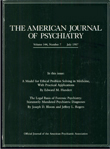Abstract
OBJECTIVE: Stressful life events, long-term difficulties, and high neuroticism are established risk factors for depression. Less is known about their role in late-life depression, how they modify or mediate one another’s effects, and whether this differs between major and subsyndromal, first and recurrent episodes. METHOD: The authors used a prospective case-control design nested in a community survey of elderly subjects that included a measure of neuroticism. They compared 83 survey participants who subsequently developed a depressive episode with 83 randomly selected comparison participants. The authors determined dates of onset, history, and severity of episodes and dates of occurrence and severity of stressful life events and difficulties. RESULTS: Stressful life events did not mediate the effects of high neuroticism and difficulties at onset, possibly because of the uncontrollable nature of common stressful life events in later life. Without both high neuroticism and difficulties, stressful life events did not increase risk. High neuroticism and difficulties increased risk, even without a stressful life event. In the presence of high neuroticism and/or difficulties, the depressogenic effect of stressful life events was substantial, suggesting effect modification. The authors found no evidence to suggest etiological discontinuity between major and subsyndromal episodes. First and recurrent episodes showed a discontinuous pattern of associations. Severe stressful life events had weaker associations, but high neuroticism and mild stressful life events had stronger associations with recurrent than with first episodes. CONCLUSIONS: This study demonstrated the usefulness of a dynamic stress-vulnerability model for understanding late-life depression. Evidence was found suggesting etiological discontinuity between first and recurrent but not between major and subsyndromal episodes.



